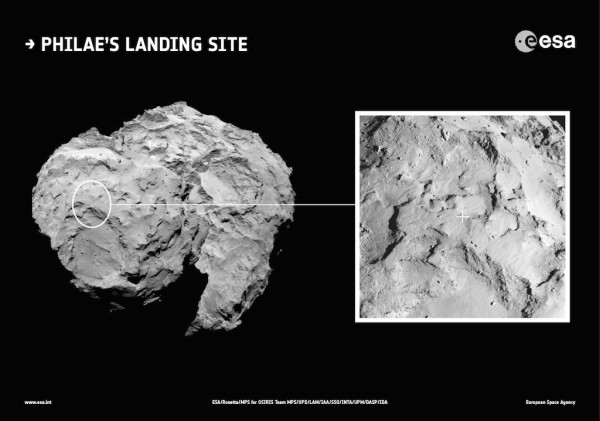ESA Picks Landing Site on Comet 67P
| Ana Verayo | | Sep 15, 2014 10:25 PM EDT |
(Photo : ESA) The Rosetta probe's Philae lander will land on Comet 67P/Churyumov-Gerasimenko's Site J on November 12.
The European Space Agency (ESA) said it's finally chosen a landing site on Comet 67P/Churyumov-Gerasimenko on which the Rosetta probe's Philae lander will touch down.
The Rosetta probe was in deep space for 10 years chasing the comet. It caught up with the comet last month.
Like Us on Facebook
Since then, ESA scientists have been busy trying to figure out the safest landing site for Philae on the oddly and irregularly shaped comet.
The site isn't ideal, according to the ESA team. But after an important meeting with France's space agency, Centre National D'études Spatiales (CNES) held at Toulouse over the weekend, a unanimous vote was given to land Philae on Site J.
Comet 67P/Churyumov-Gerasimenko's topography consists of an odd shape similar to a rubber duck about. It's 2.5 miles across its longest point.
Next year, the Rosetta probe will continue to follow the comet as the comet re-enters the solar system and zips through the Sun's orbit.
Philae will help scientists further study the comet. Rosetta has captured photos of the comet's terrain that show steep slopes and deep crevices, obviously not great landing sites for Philae.
But the reason why scientists chose Site J was because its shallow slopes are relatively safer and will help prevent Philae from falling and toppling over as it lands on the comet.
It will take about seven hours for Philae to land on Site J, said the Landing Site Selection Group. Philae will anchor itself on the comet by drilling into the surface with ice screws as soon as it makes its landing on November 11.
Other benefits of Site J include a daily dose of enough light to recharge the lander's batteries to full power and an advantageous straightforward trajectory for the landing.
Philae will help scientists further study the terrain and topography of the comet. ESA scientists are interested in the comet's icy core and believe data from the core could help unlock some hidden truth about the solar system's early formation.
Comets believed to be ancient relics from the formation of the solar system.
TagsWhere Will Rosetta Probe's Philae Land on Comet 67P? ESA Finally Reveals Landing Site, rosetta comet, Comet 67P/Churyumov-Gerasimenko, rosetta philae comet, ESA, european space agency, landing site for rosetta comet, 67p comet
©2015 Chinatopix All rights reserved. Do not reproduce without permission
EDITOR'S PICKS
-

Did the Trump administration just announce plans for a trade war with ‘hostile’ China and Russia?
-

US Senate passes Taiwan travel bill slammed by China
-

As Yan Sihong’s family grieves, here are other Chinese students who went missing abroad. Some have never been found
-

Beijing blasts Western critics who ‘smear China’ with the term sharp power
-

China Envoy Seeks to Defuse Tensions With U.S. as a Trade War Brews
-

Singapore's Deputy PM Provides Bitcoin Vote of Confidence Amid China's Blanket Bans
-

China warns investors over risks in overseas virtual currency trading
-

Chinese government most trustworthy: survey
-

Kashima Antlers On Course For Back-To-Back Titles
MOST POPULAR
LATEST NEWS
Zhou Yongkang: China's Former Security Chief Sentenced to Life in Prison

China's former Chief of the Ministry of Public Security, Zhou Yongkang, has been given a life sentence after he was found guilty of abusing his office, bribery and deliberately ... Full Article
TRENDING STORY

China Pork Prices Expected to Stabilize As The Supplies Recover

Elephone P9000 Smartphone is now on Sale on Amazon India

There's a Big Chance Cliffhangers Won't Still Be Resolved When Grey's Anatomy Season 13 Returns

Supreme Court Ruled on Samsung vs Apple Dispute for Patent Infringement

Microsoft Surface Pro 5 Rumors and Release Date: What is the Latest?










